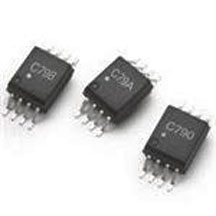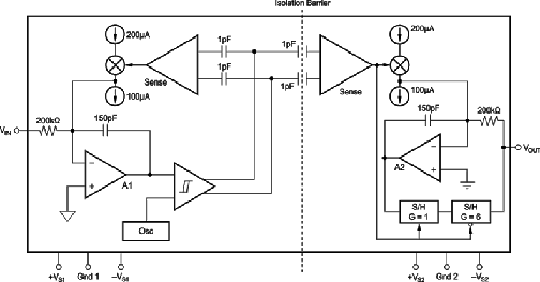Isolating an analog signal is never a trivial task. Perhaps the quintessential application is in a power converter feedback loop. Here you don’t usually need high speed and a simple optocoupler – properly biased – will do just fine. But, there may be some newer ICs that can improve on this task for very little cash. Another application is for sensor data, and here the isolated amplifier is the cats meow. Again, there are some low cost variants these days. One form of sensor data gathering is for high side current sensing. We’ll look at four of your many available options.
The Avago ACPL-C790 isolation amplifier is designed for current and voltage sensing in power converters and motor drives using an external shunt resistor. A differential output voltage proportional to the current through the shunt is created on the output of the optical isolation barrier. It has ±3% gain tolerance and operates from a single 5 V supply with 60 dB SNR, 200 kHz bandwidth, –50 ppm/°C gain drift, 0.6 mV input offset voltage, and 0.05% linearity. The IC features a fast 1.6 μs response time, common-mode transient immunity of 15 kV/μs, and –40°C to +105°C operation. It costs $6.59 in single quantity.

Avago ACPL-C790 isolation amplifier
The ISO124 precision isolation amplifier from Texas Instruments incorporates a duty cycle modulation-demodulation technique. The signal is transmitted digitally across a 2-pF differential capacitive barrier. With digital modulation, the barrier characteristics do not affect signal integrity, resulting in excellent reliability and good high-frequency transient immunity across the barrier. Both barrier capacitors are imbedded in the plastic body of the package.

ISO124 precision isolation amplifier from Texas Instruments
The device is rated for 1500 Vrms and features 0.010% maximum nonlinearity with 50-kHz signal bandwidth and 200-µV/°C VOS drift. No external components are needed. Power supply range is ±4.5 to ±18 V with quiescent currents of ±5 mA on VS1 and ±5.5 mA on VS2. The ISO124 has a slew rate of 2 V/µs and comes in PDIP-16 and SOIC-28 plastic surface-mount packages. Isolation mode rejection at 60 HZ is 140 db and the IC is specified over –25° to 85°C. From $9.33 ea/1,000.
The IL300 linear optocoupler from Vishay has a AlGaAs IRLED irradiating an isolated feedback and an output PIN photodiode in a split arrangement. The feedback photodiode output can be used to servo the LED drive current. This technique compensates for the LED’s non-linear, time, and temperature characteristics. The output PIN photodiode signal is linearly related to the input current. The time and temperature stability of the input-output coupler gain is insured by using matched PIN photodiodes.

The IL300 linear optocoupler from Vishay
The input infrared emitter operates efficiently from 500 μA to 40 mA. Best linearity is between 5 mA and 20 mA (± 0.25%). Bandwidth is 200 KHz and isolation test voltage is 5,300 VRMS for 1 second. The parts transfer gain is between 0.56 and 1.6, which is a selection bin in the part number. Transfer gain temperature stability is shown as ± 0.15%/°C worst case – typically ± 0.005% – quite a big difference there. Operating temperature is -55° to +100°C. It comes in dip- and SMD-8 packages with price ranging from $2.10 to $5.96/1,000.
The Analog Devices ADuM4190 isolated error amplifier targets linear feedback loops in power supplies. The ICs primary side controller enables excellent transient response, power density, and stability as compared to commonly used optocoupler and shunt regulator solutions. Unlike optocoupler-based solutions, the ICs transfer function does not change over its lifetime and is stable over its wide operating temperature range of −40°C to +125°C.

Analog Devices ADuM4190 isolated error amplifier
The chip features 0.5% initial accuracy and 1% over the full temperature range, using its 1.225 V reference. The device is fast enough to allow a feedback loop to react to fast transient conditions and overcurrent conditions with a 200 or 400 KHz (optional) bandwidth. It has a wideband op amp for a variety of common power supply loop compensation techniques and a CMRR of 72 db. The IC uses transformer isolation and is packaged in a wide body, 16-lead SOIC package with a reinforced 5 kV rms isolation voltage rating. It needs
Advertisement
Learn more about Electronic Products Magazine





